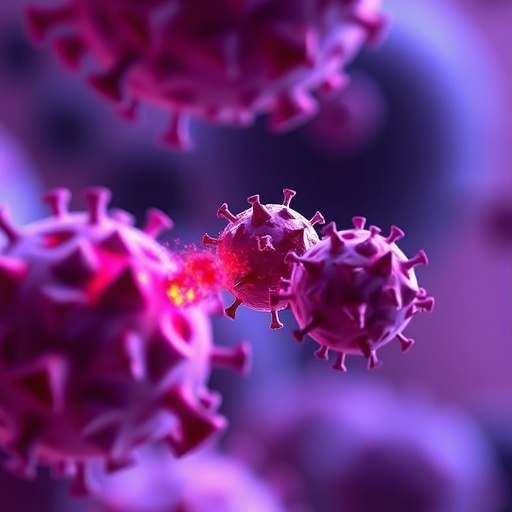In recent years, the landscape of cancer therapy has undergone a profound transformation, characterized by a shift from conventional treatment strategies towards innovative approaches that harness the power of the immune system. Among these groundbreaking advancements, the emergence of chimeric antigen receptor macrophages (CAR-M) stands out, representing a maturation of immunotherapy paradigms that may redefine how we combat cancer. The recent publication by Jing, Chen, and Chi et al. sheds light on this revolutionary development, putting forth compelling arguments regarding the role of macrophages in tumor eradication.
Macrophages are versatile immune cells, known for their ability to adapt and respond to various stimuli. They are instrumental in orchestrating the immune response against tumors. They function not only as phagocytes that engulf and destroy pathogen-infected cells and debris but also play a crucial role in modulating the adaptive immune response. The research team’s investigations have revealed that by engineering macrophages to express chimeric antigen receptors, these cells can be programmed to specifically target tumor antigens, thus enhancing their tumoricidal capabilities. The implications of this approach are staggering and offer hope where traditional therapies have faltered.
The primary mechanism behind CAR-M involvement in cancer treatment involves the re-programming of macrophages to recognize and attack cancer cells. By integrating synthetic receptor genes into macrophages, researchers can enhance these cells’ ability to home in on tumors and destroy them more effectively than conventional macrophages. The study underscores the fundamental differences between CAR-M and CAR T-cell therapies, emphasizing that while the latter have garnered much attention in the fight against hematological malignancies, their applications in solid tumors remain limited. In contrast, CAR-M players are positioning themselves to fill this critical gap.
Such an advanced immunotherapy required extensive understanding and manipulation of the tumor microenvironment (TME), where cancer cells interact with immune cells, stromal elements, and extracellular matrix components. The authors explain that CAR-Ms can alter the immunosuppressive nature of the TME, essentially transforming it into a milieu that is more conducive to anti-tumor immunity. By targeting cell-surface antigens specifically overexpressed on tumor cells, CAR-Ms can circumvent the evasive strategies typically employed by tumors, including immune checkpoint inhibition.
The challenge of tumor heterogeneity is also addressed, where the varying expressions of tumor antigens can render single-target therapies ineffective. The ingenious design of dual or multi-specific CAR-Ms is proposed as a solution within the study. By equipping macrophages with multiple receptors that target various tumor antigens simultaneously, there is a formidable strategy to overcome antigen escape variants, offering a more robust and resilient approach to cancer therapy.
An essential aspect of this novel therapy is the safety profile of CAR-Ms. Unlike traditional chemotherapy and radiation therapies that indiscriminately target both malignant and healthy cells, CAR-Ms can be designed with built-in safety switches. These safety measures ensure that if macrophages encounter tissue damage or adverse reactions during therapy, they can be reprogrammed or eliminated selectively. This feature not only mitigates potential side effects but also enhances patient acceptance of CAR-M therapies.
The manufacturing process of CAR-M cells is pivotal for their clinical application. The authors delve into the cutting-edge techniques utilized to isolate and engineer macrophages from patient-derived samples, highlighting the potential for personalized medicine approaches. This customization allows for the selection of macrophages that have an innate preference for attacking the patient’s specific tumor type, thereby maximizing therapeutic efficacy.
Clinical trials are critical for validating the notional benefits of CAR-M therapy. The article outlines several ongoing studies aiming to evaluate the safety and efficacy of CAR-M in various cancer cohorts, including details about dosages, administration routes, and patient selection criteria. The preliminary data presented is encouraging, indicating promising response rates and favorable safety profiles, thus leading researchers to remain optimistic about future approvals.
The key to oncological success lies in the collaboration across multiple disciplines. The synergistic interplay between biologists, clinicians, and engineers has been instrumental in evolving CAR-M research from the laboratory bench to bedside applications. The article emphasizes how such collaborative efforts catalyze innovations and accelerate the translation of findings into actionable therapies.
As CAR-M therapies inch closer toward clinical implementation, there remain critical considerations related to regulatory pathways and market access. The authors call for comprehensive dialogues among stakeholders, including cell therapy manufacturers and regulatory agencies, to ensure that the groundwork for a viable commercial landscape for CAR-M therapies is laid. As with any cutting-edge technology, understanding the nuances of the regulatory framework will be essential for navigating the complex waters of healthcare delivery.
The future landscape of cancer treatment appears promising with the influx of innovative solutions like CAR-M. The potential transition from laboratory research to clinical adoption could captivate both the scientific community and patients looking for alternatives to traditional treatments. The authors project a multidimensional future for CAR-M, whereby ongoing research will uncover new applications and synergies with existing therapies, further bolstering their therapeutic arsenal against cancer.
In conclusion, Jing, Chen, and Chi et al.’s exploration of CAR-M technology exemplifies the pivotal shift towards personalized, immunologically-driven cancer therapies. The momentum generated from this research will likely spur additional studies and collaborative efforts, heralding a new age in oncology where tailored therapies can provide hope and increased survival for countless patients battling cancer. As research progresses, the convergence of biological, technological, and engineering innovations will be crucial, ultimately paving the way for comprehensive cancer treatments that effectively utilize the capabilities of the immune system.
Subject of Research: Chimeric antigen receptor macrophages in cancer immunotherapy
Article Title: New power in cancer immunotherapy: the rise of chimeric antigen receptor macrophage (CAR-M)
Article References:
Jing, J., Chen, Y., Chi, E. et al. New power in cancer immunotherapy: the rise of chimeric antigen receptor macrophage (CAR-M).
J Transl Med 23, 1182 (2025). https://doi.org/10.1186/s12967-025-07115-9
Image Credits: AI Generated
DOI:
Keywords: CAR-M, cancer immunotherapy, macrophages, tumor microenvironment, personalized medicine




